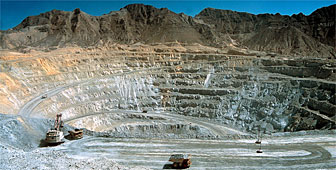Prospects rise for gold-diggers

Researchers in Zurich appear to have struck gold with a new way of determining how much of the precious metal is present in the ground.
The simple and quick technique could benefit mining companies, who traditionally analyse large amounts of rocks from drill holes to determine the quantity of metals and minerals.
The new approach analyses specks of rock, just a few micrometres across, which were swept up from the earth’s crust during volcanic activity and can be gathered as samples on the ground.
A team from the Federal Institute of Technology in Zurich has discovered that the ratios of copper and gold in these droplets of molten sulphides are identical to their overall amounts in the surrounding rock.
Profitable mining
“By analysing these little droplets, which takes a matter of days, we can predict what the relative amount of copper and gold is within the ore deposits without having to go into extensive drilling,” said Werner Halter, a researcher at the institute’s department of earth sciences.
The world’s richest sources of ores lie in porphyry deposits, which form when magma chambers deep in the Earth’s crust release gases and fluids. As these rise and cool, they deposit seams of metals such as copper and gold.
Gold as a by-product significantly increases the value of the ore and determines whether a deposit will be profitable for mining companies to exploit.
“It is essential to know what the composition of the ore is because obviously if you only extract copper, the value of the ore is much less than if you have copper and gold at the same time,” Halter told swissinfo.
Range of metals
Halter and his colleagues, Thomas Pettke and Christoph Heinrich, used mass spectrometry techniques to test samples which were taken from a copper mine in Catamarca province in northwest Argentina.
Tests on similar deposits containing elements like platinum and palladium also produced positive results.
Halter said the technique should work for a range of metals, including molybdenum, tungsten and tin.
He said the next step was to work with samples of unknown, unexploited deposits and try to test the application.
by Vincent Landon

In compliance with the JTI standards
More: SWI swissinfo.ch certified by the Journalism Trust Initiative
You can find an overview of ongoing debates with our journalists here. Please join us!
If you want to start a conversation about a topic raised in this article or want to report factual errors, email us at english@swissinfo.ch.